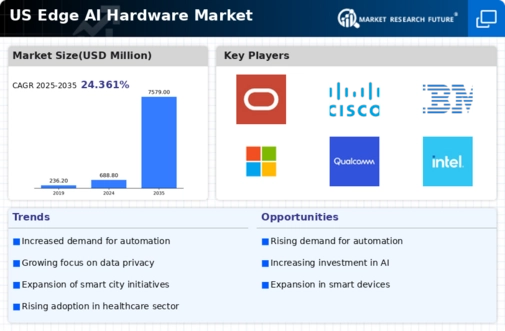The US Edge AI Hardware Market is emerging as a critical segment within the broader landscape of artificial intelligence technologies, characterized by rapid advancements and competitive dynamics that drive innovation and growth. Edge AI refers to the process of performing artificial intelligence tasks locally on hardware devices, which reduces latency, enhances data privacy, and optimizes bandwidth usage. As sectors such as automotive, healthcare, industrial automation, and smart cities increasingly adopt AI-powered solutions, the demand for high-performance edge AI hardware is witnessing significant growth.
This environment has fostered a competitive atmosphere where leading technology companies strive to differentiate their offerings through superior processing capabilities, energy efficiency, and integrated solutions that cater specifically to edge computing needs. As businesses aim to leverage real-time data processing and intelligent decision-making, the competition is intensifying among key players to capture market share in this rapidly evolving domain.
AMD has established a strong presence in the US Edge AI Hardware Market by leveraging its advanced processing technology and a versatile product portfolio designed for edge applications. The company is known for its high-performance processors and graphics units that cater to a variety of use cases, including machine learning, computer vision, and robotics. One of AMD's strengths lies in its innovative architecture that combines power efficiency with superior computing capabilities, making its products highly desirable for enterprises seeking effective edge solutions.
Additionally, AMD's commitment to continuous research and development has enabled it to keep pace with evolving market requirements and emerging technologies. Its collaborations and strategic partnerships with other industry players further enhance AMD's market position, enabling the company to provide integrated platforms that seamlessly address the complexities of edge AI implementations across diverse sectors in the US.
Oracle has made significant strides in the US Edge AI Hardware Market by offering a portfolio of solutions that address the unique needs of edge computing. The company provides advanced hardware and software solutions that facilitate intelligent data processing and analytics at the edge, ensuring organizations can harness real-time insights. Oracle’s strengths include its robust cloud infrastructure, which allows for seamless integration of edge devices with enterprise applications, coupled with its strong focus on data security and compliance, particularly crucial in industries such as finance and healthcare.
In recent years, Oracle has engaged in strategic mergers and acquisitions to strengthen its position in the edge space, acquiring firms with complementary technologies that enhance its product offerings. Notable key services include edge-to-cloud solutions that empower businesses to maximize the potential of their data, reinforcing Oracle’s reputation as a leader in the US Edge AI Hardware Market with integrated capabilities that align with the growing demand for efficient and secure edge deployments.





















Leave a Comment